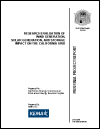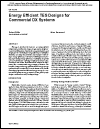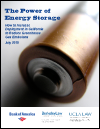Whitepapers and Reports

Electric Energy Storage – Assessment of Barriers and Opportunities
California Public Utility Commission - Staff, July 2010
California policymakers support the development of EES because it can provide an advantageous strategy for meeting the state’s long-term clean energy goals while maintaining system reliability. However, relatively little information about EES costs and benefits is available to form a rational basis for policy action. The purpose of this paper is to identify for policymakers the opportunities for and barriers to the development and deployment of EES technologies throughout California’s electricity system.
Download (530 KB pdf file)
Research Evaluation of Wind Generation, Solar Generation, & Storage Impact on the California Grid
California Energy Commission - KEMA, June 2010
This report analyzes the effect of increasing renewable energy generation on California’s electricity system and assesses and quantifies the systemʹs ability to keep generation and energy consumption (load) in balance under different renewable generation scenarios. In particular, researchers assessed four key elements necessary for integrating large amounts of renewable generation on California’s power system. Researchers concluded that accommodating 33 percent renewables generation by 2020 will require major alterations to system operations. They also noted that California may need between 3,000 to 5,000 or more megawatts (MW) of conventional (fossil‐fuel‐powered or hydroelectric) generation to meet load and planning reserve margin requirements.
Download (2 MB pdf file)
ASHRAE: Energy Efficient TES Designs for Commercial DX Systems
ASHRAE - Ice Energy, May 2010
This paper describes the basis for an energy efficient refrigerant-based thermal energy storage system design for commercial DX systems. A description of a system is given, and design aspects contributing to energy efficiency are identified. Similarly, operating characteristics and strategies contributing to energy efficiency are discussed. Challenges in measuring and predicting energy efficiency are identified, along with a proposed method for collecting certified performance data, and sample test results. Field data is then analyzed to determine if it is consistent with energy savings predictions. The benefits of using such energy efficient thermal energy storage systems are then considered for several climate zones. Results show that refrigerant-based thermal energy storage for commercial DX systems is energy neutral or better given specific design considerations and operating strategy.
Download (1 MB pdf file)The Role of Energy Storage with Renewable Electricity Generation
National Renewable Energy Laboratory, January 2010
This report explores the role of energy storage in the electricity grid, focusing on the effects of large-scale deployment of variable renewable sources (primarily wind and solar energy). It discusses the existing grid and the current role that energy storage has in meeting the constantly varying demand for electricity, as well as the need for operating reserves to achieve reliable service. The impact of variable renewables on the grid is then discussed, including how these energy sources will require a variety of enabling techniques and technologies to reach their full potential. Finally, the potential role of several forms of enabling technologies, including energy storage is evaluated.
Download (1 MB pdf file)
The Power of Energy Storage: How to Increase Deployment in California to Reduce Greenhouse Gas Emissions
Sunshine and wind, even in California, are intermittent resources, while the state’s energy needs run twenty-fours hours of every day. As California seeks to expand solar and wind power, storage of that energy for use at any time, day or night, becomes critical.
Download (4 MB pdf file)Smart Grid News Smart Grid Scorecard: Ice Energy Storage System Evaluation
Used with existing controls, the Ice Bear™ distributed energy storage technology provides a significant permanent peak load shift benefit to both end users and grid operators. The technology from Ice Energy LLC also has a significant upside that can be realized with some key investments.
Download (602 KB pdf file)



